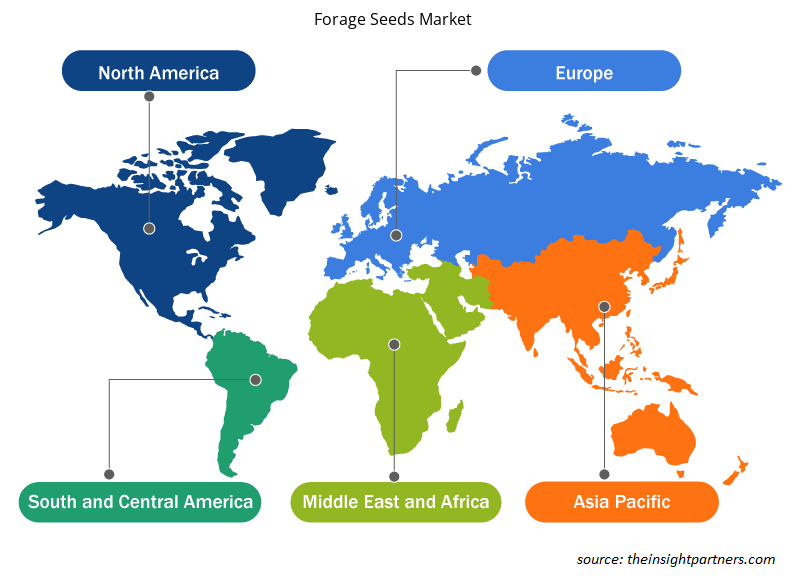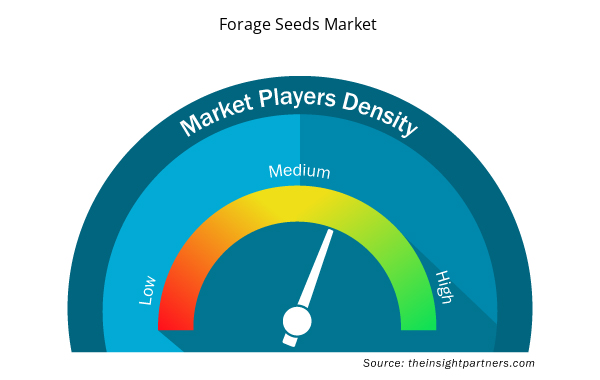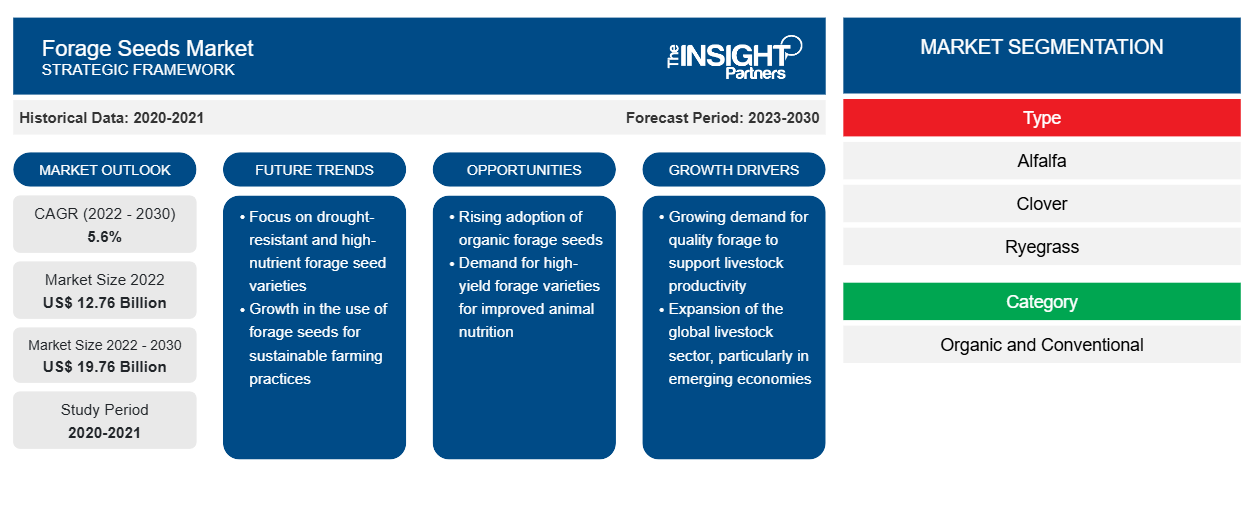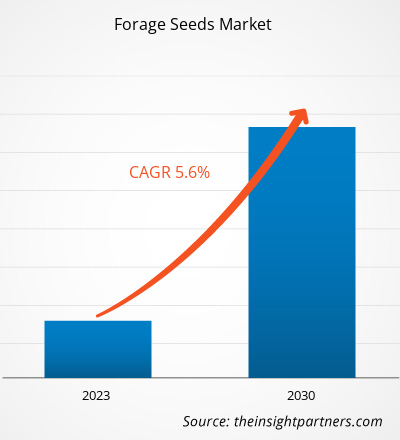[調査レポート] 市場は2022年の127億5,700万米ドルから2030年には197億5,546万米ドルに成長すると予想されており、 2022年から2030年にかけて5.6%のCAGRを記録すると予想されています。
市場洞察とアナリストの見解:
従来の飼料には、動物が摂取すると肉質を損なう化学物質が大量に含まれていることがよくあります。長期的には、そのような肉の摂取はさまざまな健康障害を引き起こします。この問題を克服するために、製造業者は化学添加物を含まないオーガニック飼料を開発しています。そのような飼料を食べた動物は、栄養価の高い肉を提供します。そのため、消費者は、従来の製品よりも健康的な代替品としてオーガニック製品や天然製品を見つけることがよくあります。消費者は主にオーガニック製品を好むため、製造業者はオーガニック成分で生産された製品に多額の投資をしています。さらに、インターネットのおかげで無限の情報にアクセスしやすくなったため、消費者は健康ニーズをますます意識するようになり、オーガニック飼料の需要が高まっています。したがって、予測期間中、オーガニック飼料の好みの高まりは、飼料種子市場の重要なトレンドになると予想されます。
成長の原動力と課題:
種子遺伝学の技術的改善は、世界の飼料種子市場の成長の機会を提供します。種子メーカーは、技術開発により、ハイブリッド、GMO、非GMO、有機種子など、さまざまな品種や特性の種子を開発してきました。雑草や病気による作物の損失を最小限に抑え、種子の品質を向上させるため、さまざまな飼料栽培地域で、農家によるこれらの遺伝子組み換え品種の好みが徐々に高まっています。ハイブリッド種子は、同じ種の2つの異なる親植物の特別な、慎重に管理された交配によって開発され、同じ植物の2つの近親交配では生み出せない新しい特性を生み出します。通常、ハイブリッド種子は手作業で交配されます。
GMO 種子は遺伝子工学によって生産され、生物の遺伝物質を改変します。GMO 種子は、最新のバイオテクノロジー技術を使用して研究室で栽培されます。一方、非 GMO 種子は受粉によって栽培されます。有機種子は非 GMO 種子と見なされます。有機種子は、殺虫剤、肥料、その他の化学物質の助けを借りずに自然に生産されます。これらの種子は病気に強く、悪条件でも繁栄する能力が強化されています。
これらの育種技術により、種子や植物細胞の DNA を改変することで、望ましい特性を持つ新しい種子の品種を開発できます。これらの技術の改良は、農家が飼料種子の栽培中に直面する課題の解決に役立ちます。したがって、絶え間ない技術の改良により、今後数年間で飼料種子市場に有利な機会が生まれることが期待されます。
要件に合わせてレポートをカスタマイズする
このレポートの一部、国レベルの分析、Excelデータパックなど、あらゆるレポートを無料でカスタマイズできます。また、スタートアップや大学向けのお得なオファーや割引もご利用いただけます。
- このレポートの主要な市場動向を入手してください。この無料サンプルには、市場動向から見積もりや予測に至るまでのデータ分析が含まれます。
レポートのセグメンテーションと範囲:
「世界の飼料種子市場」は、タイプ、カテゴリ、家畜、および地理に基づいてセグメント化されています。タイプに基づいて、飼料種子市場は[アルファルファ、クローバー(白、赤、ハイブリッドなど)、ライグラス(一年生ライグラス、多年生ライグラス、イタリアンライグラス、ハイブリッドライグラス)、チモシー、ソルガム、ブロム、バーズフットトレフォイル、ササゲ、メドウフェスクなど]に分類されています。カテゴリに基づいて、市場は有機と従来型に分類されています。家畜に基づいて、飼料種子市場は反芻動物、家禽、豚、その他に分類されています。飼料種子市場は、地理に基づいて、北米(米国、カナダ、メキシコ)、ヨーロッパ(ドイツ、フランス、イタリア、英国、ロシア、その他のヨーロッパ)、アジア太平洋(オーストラリア、中国、日本、インド、韓国、その他のアジア太平洋)、中東およびアフリカ(南アフリカ、サウジアラビア、UAE 、その他の中東およびアフリカ)、南米および中米(ブラジル、チリ、その他の南米および中米)に分類されます。
セグメント分析:
家畜に基づいて、飼料種子市場は反芻動物、家禽、豚、その他に分類されます。反芻動物セグメントは2022年に飼料種子市場で最大のシェアを占め、予測期間中に大幅な成長率を記録すると予想されています。反芻動物には、牛、羊、山羊、水牛が含まれます。飼料は反芻動物にとってタンパク質、繊維、エネルギーの主な供給源です。アルファルファやクローバーなどのマメ科の飼料は、反芻動物に粗タンパク質の75%を提供します。飼料草は反芻動物に大量の繊維を提供します。飼料はまた、ルーメン飼料の全体的なコストを削減します。したがって、畜産業者は通常、動物飼料と一緒に飼料を使用します。反芻動物、特に乳牛、山羊、羊、肉牛に対する特定の栄養に対する意識の高まりが飼料の需要を促進し、それによって飼料種子市場の成長を促進しています。
地域分析:
地理に基づいて、飼料種子市場は、北米、ヨーロッパ、アジア太平洋、南米および中米、中東およびアフリカの5つの主要地域に分割されています。世界の飼料種子市場は北米が主流で、2022年に約50億米ドルになると推定されています。北米は、飼料としての飼料の需要の増加、肉の消費、気象条件、価格の上昇にもかかわらず畜産物の消費が増加していること、確立された動物飼料、農業産業により、飼料種子の重要な市場の1つです。タンパク質が豊富で健康的な製品を選択する人の増加、可処分所得の増加、ライフスタイルの変化、食生活のパターンにより、米国、カナダ、メキシコでタンパク質が豊富な肉の需要が急増しています。したがって、肉製品の消費の増加に伴い、動物飼料の需要が増加し、飼料種子市場をさらに推進しています。この地域は、地域全体で最大の動物飼料生産者の1つを占めています。 Alltech Globalのレポートによると、2020年にこの地域では2億5,400万トン以上の動物飼料製品が生産されました。北米での動物飼料の大量生産と、特に肉や乳製品に関する食品安全への懸念の高まりにより、この地域では牧草などの栄養価の高い動物飼料の消費が増加しています。
北米での牛の飼育の大幅な増加も、予測期間中に牧草などの動物飼料の需要を促進すると予想されています。たとえば、Foothills Forage & Grazing Associationによると、カナダの牛の在庫は2021年7月1日時点で1,229万頭で、2020年7月1日よりも0.2%増加しました。この増加は、新鮮な肉製品の需要が高まり、牛の輸入が急増したことに起因しています。さらに、米国農務省(UDSA)のレポートによると、2021年に北米では1億1,400万頭を超える牛の在庫と1億900万頭を超える豚の在庫が記録されました。このように、牛の在庫の増加と健康的な動物飼料の需要の高まりが、地域全体の飼料種子の需要を促進しています。
業界の発展と将来の機会:
飼料種子市場で活動する主要企業が行っているさまざまな取り組みを以下に示します。
- 2022年11月、持続可能な農業ソリューションの世界的なプロバイダーであるUPL Ltd.は、同社とAdvanta Seeds UK、およびBungeがSEEDCORP|HOの株式をそれぞれ20%取得する契約を締結したことを発表しました。この投資計画は、農家向けの包括的なソリューションパッケージを提供するためのコラボレーションを推進するというUPLグループのOpenAgの目的の一環です。
- 2022年10月、世界的な投資会社KKRと世界的な農業ソリューションプロバイダーUPL Limitedは、KKRがLtdの子会社であるAdvanta Enterprises Limitedの株式13.33%を3億ドルで投資する正式契約を締結したことを発表しました。
COVID-19の影響:
COVID-19パンデミックは、さまざまな国の経済や産業に影響を及ぼしました。北米、ヨーロッパ、アジア太平洋(APAC)、南中米(SAM)、中東アフリカ(MEA)の主要国での渡航禁止、ロックダウン、事業停止は、農業や動物飼料産業を含むさまざまな産業の成長に悪影響を及ぼしました。製造ユニットの閉鎖により、世界的なサプライチェーン、配送スケジュール、製造活動、さまざまな必須および非必須製品の販売が混乱しました。さまざまな企業が、2020年に製品の配送が遅れ、製品の将来の販売が低迷する可能性があると発表しました。さらに、ヨーロッパ、アジア、北米のさまざまな政府による海外旅行の禁止により、企業はコラボレーションとパートナーシップの計画を一時的に保留せざるを得ませんでした。これらすべての要因が2020年と2021年初頭の動物飼料産業を妨げ、飼料種子市場の成長を抑制しました。
飼料種子市場の地域別洞察
予測期間を通じて飼料種子市場に影響を与える地域的な傾向と要因は、Insight Partners のアナリストによって徹底的に説明されています。このセクションでは、北米、ヨーロッパ、アジア太平洋、中東、アフリカ、南米、中米にわたる飼料種子市場のセグメントと地理についても説明します。

- 飼料種子市場の地域別データを入手
飼料種子市場レポートの範囲
| レポート属性 | 詳細 |
|---|---|
| 2022年の市場規模 | 127.6億米ドル |
| 2030年までの市場規模 | 197.6億米ドル |
| 世界のCAGR(2022年 - 2030年) | 5.6% |
| 履歴データ | 2020-2021 |
| 予測期間 | 2023-2030 |
| 対象セグメント | タイプ別
|
| 対象地域と国 | 北米
|
| 市場リーダーと主要企業プロフィール |
|
市場プレーヤーの密度:ビジネスダイナミクスへの影響を理解する
飼料種子市場は、消費者の嗜好の変化、技術の進歩、製品の利点に対する認識の高まりなどの要因により、エンドユーザーの需要が高まり、急速に成長しています。需要が高まるにつれて、企業は提供品を拡大し、消費者のニーズを満たすために革新し、新たなトレンドを活用し、市場の成長をさらに促進しています。
市場プレーヤー密度とは、特定の市場または業界内で活動している企業または会社の分布を指します。これは、特定の市場スペースに、その規模または総市場価値と比較して、どれだけの競合相手 (市場プレーヤー) が存在するかを示します。
飼料種子市場で事業を展開している主要企業は次のとおりです。
- UPL株式会社
- DLF シーズ AS
- コルテバ株式会社
- リマグレインUK社
- S&W シード社
免責事項:上記の企業は、特定の順序でランク付けされていません。

- 飼料種子市場のトップキープレーヤーの概要を入手
競争環境と主要企業:
UPL Ltd、DLF Seeds AS、Corteva Inc、Limagrain UK Ltd、S&W Seed Co、Deutsche Saatveredelung AG、Cerience、Allied Seed LLC、MAS Seeds SA、Syngenta AG は、世界の飼料種子市場で活動する著名な企業です。これらの飼料種子メーカーは、革新的な機能を備えた最先端の種子ソリューションを提供し、農家とその家畜に優れた体験を提供します。
- 過去2年間の分析、基準年、CAGRによる予測(7年間)
- PEST分析とSWOT分析
- 市場規模価値/数量 - 世界、地域、国
- 業界と競争環境
- Excel データセット



Report Coverage
Revenue forecast, Company Analysis, Industry landscape, Growth factors, and Trends

Segment Covered
This text is related
to segments covered.

Regional Scope
North America, Europe, Asia Pacific, Middle East & Africa, South & Central America

Country Scope
This text is related
to country scope.
よくある質問
The forage seeds manufacturers across the globe are investing significantly in strategic development initiatives such as product innovation, mergers and acquisitions, and expansion of their businesses to attract many consumers and enhance their market position. To maintain their strategic position in the market, key players are investing significantly in quality enhancement of forage seeds. For instance, DLF Seeds, the world's leading grass seed breeder, invested US$ 4.6 million in new state-of-the-art mixing and distribution facilities in 2021. The company has invested in transforming its current production facilities of Offshore Patrol Vessels (OPVs) and the hybrid seed of forage and bringing much-needed additional capacity and efficiency to cope with the increasing market demands by consumers and environmental stewardship in the forage seed market. Such strategic development initiatives by key players help to create a strong foothold in the market.
Based on the livestock, ruminants segment is projected to grow at the fastest CAGR over the forecast period. Ruminants include cattle, sheep, goats, and buffalo. Forage is the primary source of protein, fiber, and energy for ruminants. Leguminous forages such as alfalfa and clover provide 75% of the crude protein to ruminants. Forage grasses provide high amounts of fiber to the ruminants.
North America accounted for the largest share of the global forage seeds market. The growth in region is attributed to the increased demand for forage as feed, meat consumption, and weather conditions, as well as rising consumption of livestock products despite the rising prices, well-established animal feed, and agriculture industry. An increasing number of individuals opting for protein-rich and healthier products, growing disposable income, lifestyle changes, and eating patterns contribute to a surge in demand for protein-rich meat in the US, Canada, and Mexico. Thus, with the rising consumption of meat products, the demand for animal feed increases and further drives the market for forage seeds. The region accounts for one of the largest animal feed producers across the region. As per the report of Alltech Global, in 2020, the region produced more than 254 million metric tons of animal feed products. The mass production of animal feed in North America and the rising food safety concerns, especially about meat and dairy products, have led to the increased consumption of nutritional animal feed such as forages in the region.
Based on category, conventional segment mainly has the largest revenue share. Conventional forage seeds are grown using chemical fertilizers, genetically modified organisms (GMOs), and chemical pesticides. Conventional forage seeds provide higher yields than organic ones due to the use of GMOs and chemical fertilizers. Moreover, conventional forage seeds are highly affordable and readily available.
The major players operating in the global forage seeds market are UPL Ltd, DLF Seeds AS, Corteva Inc, Limagrain UK Ltd, S&W Seed Co, Deutsche Saatveredelung AG, Cerience, Allied Seed LLC, MAS Seeds SA, and Syngenta AG.
The seed manufacturers have developed different varieties or traits of seeds, such as hybrid, GMO, non-GMO, and organic seeds, with technological developments. The farmer's preference for these transgenic varieties is slowly rising in various forage-growing regions to minimize crop losses by weeds and diseases and enhance the quality of seeds. The hybrid seeds are developed by the special, carefully controlled cross-pollination of two different parent plants of the same species to produce new traits that cannot be created by the inbreeding of two of the same plants. Usually, the hybrid seeds are cross-pollinated by hand.
Trends and growth analysis reports related to Food and Beverages : READ MORE..
The List of Companies - Forage Seeds Market
- UPL Ltd
- DLF Seeds AS
- Corteva Inc
- Limagrain UK Ltd
- S&W Seed Co
- Deutsche Saatveredelung AG
- Cerience
- Allied Seed LLC
- MAS Seeds SA
- Syngenta AG
The Insight Partners performs research in 4 major stages: Data Collection & Secondary Research, Primary Research, Data Analysis and Data Triangulation & Final Review.
- Data Collection and Secondary Research:
As a market research and consulting firm operating from a decade, we have published and advised several client across the globe. First step for any study will start with an assessment of currently available data and insights from existing reports. Further, historical and current market information is collected from Investor Presentations, Annual Reports, SEC Filings, etc., and other information related to company’s performance and market positioning are gathered from Paid Databases (Factiva, Hoovers, and Reuters) and various other publications available in public domain.
Several associations trade associates, technical forums, institutes, societies and organization are accessed to gain technical as well as market related insights through their publications such as research papers, blogs and press releases related to the studies are referred to get cues about the market. Further, white papers, journals, magazines, and other news articles published in last 3 years are scrutinized and analyzed to understand the current market trends.
- Primary Research:
The primarily interview analysis comprise of data obtained from industry participants interview and answers to survey questions gathered by in-house primary team.
For primary research, interviews are conducted with industry experts/CEOs/Marketing Managers/VPs/Subject Matter Experts from both demand and supply side to get a 360-degree view of the market. The primary team conducts several interviews based on the complexity of the markets to understand the various market trends and dynamics which makes research more credible and precise.
A typical research interview fulfils the following functions:
- Provides first-hand information on the market size, market trends, growth trends, competitive landscape, and outlook
- Validates and strengthens in-house secondary research findings
- Develops the analysis team’s expertise and market understanding
Primary research involves email interactions and telephone interviews for each market, category, segment, and sub-segment across geographies. The participants who typically take part in such a process include, but are not limited to:
- Industry participants: VPs, business development managers, market intelligence managers and national sales managers
- Outside experts: Valuation experts, research analysts and key opinion leaders specializing in the electronics and semiconductor industry.
Below is the breakup of our primary respondents by company, designation, and region:

Once we receive the confirmation from primary research sources or primary respondents, we finalize the base year market estimation and forecast the data as per the macroeconomic and microeconomic factors assessed during data collection.
- Data Analysis:
Once data is validated through both secondary as well as primary respondents, we finalize the market estimations by hypothesis formulation and factor analysis at regional and country level.
- Macro-Economic Factor Analysis:
We analyse macroeconomic indicators such the gross domestic product (GDP), increase in the demand for goods and services across industries, technological advancement, regional economic growth, governmental policies, the influence of COVID-19, PEST analysis, and other aspects. This analysis aids in setting benchmarks for various nations/regions and approximating market splits. Additionally, the general trend of the aforementioned components aid in determining the market's development possibilities.
- Country Level Data:
Various factors that are especially aligned to the country are taken into account to determine the market size for a certain area and country, including the presence of vendors, such as headquarters and offices, the country's GDP, demand patterns, and industry growth. To comprehend the market dynamics for the nation, a number of growth variables, inhibitors, application areas, and current market trends are researched. The aforementioned elements aid in determining the country's overall market's growth potential.
- Company Profile:
The “Table of Contents” is formulated by listing and analyzing more than 25 - 30 companies operating in the market ecosystem across geographies. However, we profile only 10 companies as a standard practice in our syndicate reports. These 10 companies comprise leading, emerging, and regional players. Nonetheless, our analysis is not restricted to the 10 listed companies, we also analyze other companies present in the market to develop a holistic view and understand the prevailing trends. The “Company Profiles” section in the report covers key facts, business description, products & services, financial information, SWOT analysis, and key developments. The financial information presented is extracted from the annual reports and official documents of the publicly listed companies. Upon collecting the information for the sections of respective companies, we verify them via various primary sources and then compile the data in respective company profiles. The company level information helps us in deriving the base number as well as in forecasting the market size.
- Developing Base Number:
Aggregation of sales statistics (2020-2022) and macro-economic factor, and other secondary and primary research insights are utilized to arrive at base number and related market shares for 2022. The data gaps are identified in this step and relevant market data is analyzed, collected from paid primary interviews or databases. On finalizing the base year market size, forecasts are developed on the basis of macro-economic, industry and market growth factors and company level analysis.
- Data Triangulation and Final Review:
The market findings and base year market size calculations are validated from supply as well as demand side. Demand side validations are based on macro-economic factor analysis and benchmarks for respective regions and countries. In case of supply side validations, revenues of major companies are estimated (in case not available) based on industry benchmark, approximate number of employees, product portfolio, and primary interviews revenues are gathered. Further revenue from target product/service segment is assessed to avoid overshooting of market statistics. In case of heavy deviations between supply and demand side values, all thes steps are repeated to achieve synchronization.
We follow an iterative model, wherein we share our research findings with Subject Matter Experts (SME’s) and Key Opinion Leaders (KOLs) until consensus view of the market is not formulated – this model negates any drastic deviation in the opinions of experts. Only validated and universally acceptable research findings are quoted in our reports.
We have important check points that we use to validate our research findings – which we call – data triangulation, where we validate the information, we generate from secondary sources with primary interviews and then we re-validate with our internal data bases and Subject matter experts. This comprehensive model enables us to deliver high quality, reliable data in shortest possible time.


 このレポートの無料サンプルを入手する
このレポートの無料サンプルを入手する